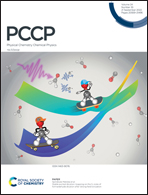Unravelling the robustness of magnetic anisotropy of a nickelocene molecule in different environments: a first-principles-based study†
Abstract
Recent scanning tunneling spectroscopy with single metallocene molecule-functionalized tips have proved to be a powerful tool to probe and control individual spins and spin–spin exchange interactions due to the robustness of the magnetic properties of the metallocene molecule in different surroundings. However, accurate prediction of such robustness at a first-principles-based level by the conventional density functional theory (DFT) has remained challenging. In this paper, we have performed a detailed investigation of the evolution of electronic and magnetic properties of a nickelocene molecule (NiCp2) in different environments, i.e., free-standing, adsorbed on Cu(100) and as a functionalized tip apex. Using an embedding method, which combines DFT and the complete active space self-consistent field (CASSCF) method recently developed, we demonstrate that the nickelocene molecule almost preserves its spin and magnetic anisotropy upon adsorption on Cu(100), and also in the position of the tip apex. In particular, the cyclic π* orbital of the Cp rings could hybridize with the singly occupied dπ orbitals of the Ni center of the molecule, protecting these orbitals from external states. Hence the molecular spin maintains S = 1, the same as in the free-standing case, and its magnetic anisotropy is also robust with energies of 3.56, 3.34, and 3.51 meV in free-standing, adsorbed on Cu(100), and functionalized tip apex states, respectively, in good agreement with previous theoretical and experimental results. This work thus provides a first-principles-based understanding of the relevant experiments. Such agreement between theoretical simulations and experimental measurements highlights the potential usefulness of the method for investigating the local electronic and spin states of organometallic molecule–surface composite systems.



 Please wait while we load your content...
Please wait while we load your content...